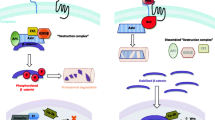Abstract
The Wnt signaling pathway is involved in both normal development and tumorigenesis. Activation of the pathway results in stabilization and nuclear translocation of beta-catenin protein. Nuclear localization of beta-catenin has been used to identify tumors in which mutations in APC or beta-catenin activate Wnt signaling. We analyzed the subcellular localization of beta-catenin immunohistochemically in human fetal and postnatal tissues to identify activation of Wnt signaling during development. Nuclear beta-catenin is present in capillary endothelium, mesenchyme surrounding renal tubules, adrenal cortex, cartilage anlage, placental cytotrophoblast, and pulmonary acinar buds. These investigations suggest a defined role for Wnt signaling in human fetal development and provide a catalogue of non-neoplastic tissues with nuclear beta-catenin staining.
Similar content being viewed by others
Author information
Authors and Affiliations
Additional information
Received August 2, 2000; accepted November 1, 2000.
Rights and permissions
About this article
Cite this article
Eberhart, C., Argani, P. Wnt Signaling in Human Development: Beta-Catenin Nuclear Translocation in Fetal Lung, Kidney, Placenta, Capillaries, Adrenal, and Cartilage. Pediatr. Dev. Pathol. 4, 351–357 (2001). https://doi.org/10.1007/s10024001-0037-y
Published:
Issue Date:
DOI: https://doi.org/10.1007/s10024001-0037-y




